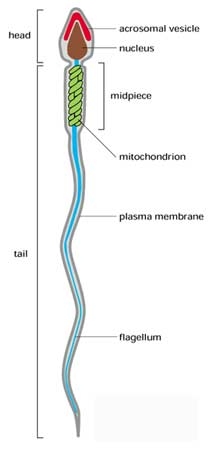 The mature sperm cell (spermatozoa)
is 0.05 milliliters long. It consists of a head, body and tail.
The head is covered by the ac cap and contains a nucleus of dense
genetic material from the 23 chromosomes.
The mature sperm cell (spermatozoa)
is 0.05 milliliters long. It consists of a head, body and tail.
The head is covered by the ac cap and contains a nucleus of dense
genetic material from the 23 chromosomes.
It is attached
from the neck to the body containing mitochondria that supply the
energy for the sperm's activity. The tail is made of protein
fibers that contract on alternative sides, giving a characteristic
wavelike movement that drives the sperm through the seminal fluid,
which also supplies additional energy.
Some sperm
have two heads or two tails and if the testes are too warm they
may die or spermatogenesis may not occur.
Sperm swim at
a rate of about 3mm (0.12 inches) per minute. That's an average,
it's different for every guy. Some sperm cells are 'better'
swimmers than others. Why? They need to wave their tales more than
1000 times just to swim 1.25 cm or a half an inch. Why some are
better than others is still a mystery to many fertility
specialists. Anyway...
Sperm cells
are made in the testes where it takes about 72 days for one sperm
to grow. Sperm production requires a temperature which is three to
five degrees below body temperature. The scrotum has a built-in
thermostat, which keeps the sperm at the correct temperature while
they're being stored. If it becomes too cool on the outside, the
scrotum will bring the testicles closer to the body for warmth as
you probably know from jumping into a cold pool of water or ocean.
That's why the testes hang away from the body -- so sperm can
develop at the temperature they need. (95° - 97° F or 35° to 36°
C)
Semen contains
small amounts of more than thirty elements, including fructose,
ascorbic acid, cholesterol, creatine, citric acid, lactic acid,
nitrogen, vitamin B12, and various salts and enzymes. Let's go
back to the inside of the head of the sperm. All normal cells have
46 chromosomes but sperm have half that number or, 23. If and when
the sperm joins ups with the female's, egg (ovum) which also has
23 chromosomes, together they add up to 46 chromosomes. The middle
section controls the sperms activities. The sperm or (spermatozoa
-- which are the little swimming critters) make up only about 5%
of what a man ejaculates each time he ejaculates. This represents
about 100 to 400 million of them! Therefore, they are very, very
tiny, in fact a single sperm is the smallest cell in the body.
The rest of
what a man ejaculates in his ejaculate, which is about a
teaspoonful (5 ml), is made up of water, sugar, protein, vitamin
C, zinc, and prostaglandins. Semen or seminal fluid is the mixture
of sperm and the secretions of the seminal vesicles, prostate
gland, and the bulbourethral glands. Over the course of a guy's
life, he'll produce more than 12 trillion sperm.

